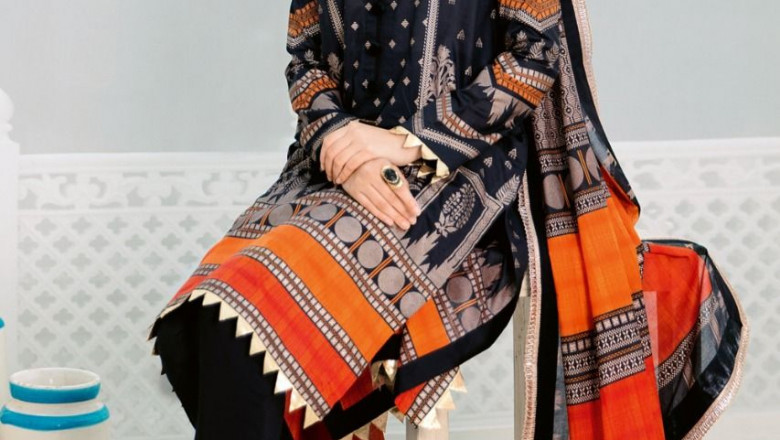views
Silk dresses have always been a showstopper in Pakistani fashion, blending luxurious fabric with traditional and contemporary designs. If you’re searching for elegance that never goes out of style, Silk dresses pakistani are where culture meets couture.
The Charm of Silk in Traditional Fashion
Silk has long been associated with grace and grandeur. Its natural sheen and fluid drape give any outfit a royal touch. In Pakistani fashion, silk has found a permanent place, especially in formal wear.
Why Pakistani Silk Dresses Stand Out
Pakistani silk dresses boast rich embroidery, cultural patterns, and intricate tailoring that reflects both modern tastes and traditional values. They are not just garments—they’re pieces of art.
Historical Significance of Silk in South Asia
Silk and Royalty – A Regal Connection
Historically, silk was reserved for nobility. In the Mughal era, emperors and queens adorned themselves in finely woven silk embellished with gold thread—an influence still visible in today's bridal wear.
Evolution of Silk Dresses in Pakistani Culture
From heavy bridal lehengas to breezy formal kurtas, silk has evolved in form and function. What started as royal garb has now become a wardrobe essential for festive and formal events.
Popular Types of Silk Used in Pakistani Dresses
Pure Silk
This is the gold standard—soft, glossy, and breathable. It’s often used in high-end couture pieces.
Banarasi Silk
Known for its rich texture and gold or silver brocade, Banarasi silk is perfect for bridal and festive wear.
Raw Silk
With a slightly rough texture and matte finish, raw silk is ideal for semi-formal wear and offers a classy, understated look.
Silk Chiffon and Georgette
Lightweight and sheer, these variants are great for draped styles like sarees and flowing gowns.
Styles and Cuts of Pakistani Silk Dresses
Anarkali Frocks
Inspired by Mughal royalty, these dresses flare out beautifully, making them a favorite for weddings and Eid.
Straight Cut Shirts
Minimalist and elegant, they can be dressed up or down depending on the event.
Maxi Dresses
Floor-length and regal, silk maxis are increasingly popular for evening events.
Lehenga Choli
The ultimate bridal outfit—silk lehengas paired with intricately embroidered cholis are nothing short of breathtaking.
Saree Style Dresses
Pakistani takes on the saree with a pre-stitched twist make draping easier while keeping the elegance intact.
Embellishments and Embroidery Work
Zari and Zardozi
Metallic threads woven into intricate designs add shimmer and luxury to any silk outfit.
Sequins and Beads
Perfect for nighttime events, these embellishments catch light and turn heads.
Hand Embroidery vs. Machine Work
While machine work is cost-effective, hand embroidery offers a personal touch and superior craftsmanship.
Seasonal Trends in Silk Dresses
Festive & Wedding Wear
Silk is a go-to fabric during festive seasons like Eid, weddings, and Diwali due to its opulence.
Casual and Semi-Formal Designs
Lighter silk blends are now used in daily wear too, featuring subtle prints and minimal embroidery.
How to Style a Pakistani Silk Dress
Accessories That Complement
Go bold with traditional jhumkas or keep it subtle with studs. The choice depends on the occasion.
Footwear to Pair With
Kolhapuri sandals for a traditional look or heels for formal flair—either works beautifully.
Dupatta Draping Tips
Drape it over one shoulder for a classic vibe or belt it at the waist for a modern twist.
Buying Guide for Pakistani Silk Dresses
Where to Shop Online and Offline
Look for trusted brands like Maria B, Sana Safinaz, and Elan. Online platforms like Sanaulla and Daraz are reliable for global shoppers.
How to Spot Quality Silk
Authentic silk feels soft, doesn’t wrinkle easily, and has a natural shine, unlike polyester blends.
Care Tips for Silk Dresses
Washing and Storing Silk
Always dry clean or gently hand wash. Store in a cool, dry place—preferably in a breathable bag.
Preventing Color Fading and Fabric Damage
Avoid direct sunlight and harsh detergents. Always iron on low heat from the reverse side.
The Global Appeal of Pakistani Silk Dresses
Celebrity Fashion Influence
From Mahira Khan to Mehwish Hayat, many Pakistani celebrities have flaunted silk outfits on red carpets.
Pakistani Designers on the International Stage
Designers like Hassan Sheheryar Yasin (HSY) and Bunto Kazmi have put Pakistani Festive wear fashion on the global map.
Sustainable Fashion and Silk Production in Pakistan
Eco-Friendly Practices Emerging in the Industry
With growing awareness, many brands are adopting organic dyes, ethical labor, and sustainable packaging.
Conclusion
Pakistani silk dresses are more than just stylish outfits—they're a celebration of culture, elegance, and craftsmanship. Whether you're attending a wedding, celebrating Eid, or just want to make a fashion statement, there’s a silk dress waiting for you to make it shine. So go ahead—wrap yourself in silk and feel the royalty in every thread.













Comments
0 comment